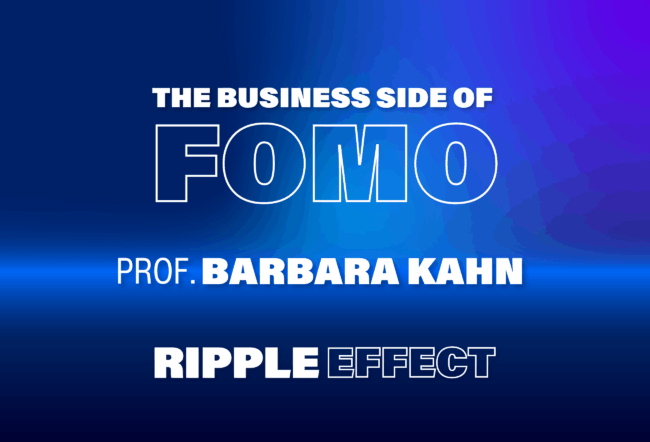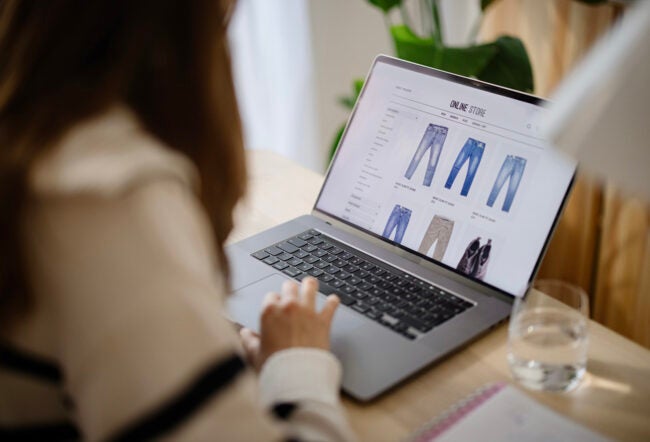Barbara E. Kahn, professor of marketing and director of the Jay .H. Baker Retailing Center, is the chair of the Retail and Consumer Goods Summit, a conference that Knowledge at Wharton is organizing in collaboration with the Baker Retailing Center on April 28 and 29 in New York City. Her research interests include consumer choice, variety seeking, product assortments, brand management and retailing.
In this wide-ranging discussion with Knowledge at Wharton about her recent research, Kahn talks about how a complete product encourages more consumption: A person is likely to eat two pieces of cheese with holes in them but only one if it is solid, for example. It’s a matter of perception, Kahn explains. She also discusses her research on the attention that consumers pay to large assortments of goods and how it influences their choices when information is presented visually or verbally. In addition, she describes a study on how consumers behave when goods are stacked vertically versus horizontally.
An edited version of the conversation follows.
Knowledge at Wharton: One of the papers that you have written recently — in collaboration with your colleague Julio Sevilla — is about the notion of a product’s completeness, and how it affects perceptions, preferences, and even the purchase decisions of buyers. What was the question you were trying to investigate in your research?
Barbara Kahn: One of the things that we know is that the way people decide what to buy and what to eat and how much to eat is not necessarily based on objective measures. It’s based more on their perceptions of how things work [or] look…. One of the big findings in the literature before we did our study was that product shape and size and package shape and size affect how much people consume. There’s been previous work that shows that keeping the size of a product the same but changing its shape can influence how much people eat. We were interested in whether or not you think the unit is complete affects how much you eat.
Knowledge at Wharton: So if I were to take a bag of cashews and eat a lot of the broken pieces at the bottom of the bag, I would not be feeling guilty, regardless of how much I consumed, because I would think I had not eaten an entire unit?
Kahn: Right. That’s the idea. Whenever you eat a whole thing, you think you’re eating more, even if the amount is the same as a broken piece. So, if you ate a whole pretzel, you would be aware that you ate a whole pretzel. If you ate a whole bunch of pieces, you’re not aware of how much quantity you’re eating.
“People are not normative decision-makers. They don’t eat what they think they need to eat to feel full. They eat what they perceive is the right amount.”
Knowledge at Wharton: How do you decide whether a product is complete or not?
Kahn: Well, that is the interesting thing. We do show that you can manipulate what the expectation is, and change people’s behavior. For example, we did a study in this research, where we had rolls or cheese. The roll was incomplete, because there was a hole in it. The cheese was incomplete, because there were holes in the cheese — it wasn’t a solid piece of bread or a solid piece of cheese. When we called it a roll or cheese, people thought the ones with the holes were less complete. They tended to consume more of the holey bread. On the other hand, if we set the expectation that it was a bagel, or that it was Swiss cheese, their thought was: “A whole bagel has a hole in it.” That reversed the findings.
Knowledge at Wharton: How did you go about conducting your research?
Kahn: We did a lot of the research online. [We asked questions like] if this is what it looked like, how much do you think you would eat? How much do you think you’d pay for it? But we did run a field study to validate the research. We did it in Miami with a class of people who were going for a health MBA course. They were physicians and health professionals. So, they were senior, sophisticated people who understood health.
We had a condition, and we had two classes. They either ate lunch in classroom A or classroom B. Lunch was sandwiches that were either cut in half or whole. We held constant in each one the amount of bread, the amount of meat, the amount of everything. We also counted how many sandwiches they ended up eating. We were careful so that a normal portion size would be more than one, because there is also a kind of bias called the unitary bias, where you might just take one of something. So, these were small sandwiches; people would naturally take more than one.
What we found is that when we cut the sandwich in half, people ate more. And, mind you, these were doctors and health professionals, who were liable to fall for this bias as well.
Knowledge at Wharton: What would you say were some of the main takeaways of your research?
Kahn: There are public policy takeaways and marketing takeaways. Basically, we add to this growing literature. There are others who have found these kinds of things. [Research has found] that people focus on the primary dimension of the product. They do insufficient adjustment for the secondary dimension. If something has a long primary dimension and a small secondary dimension, but is the same size as something with a little bit smaller primary dimension and a bigger secondary dimension, they overweight the primary dimension. That is similar to our research, where they overweight the completeness.
Basically, it shows that people are not normative decision-makers. They don’t eat what they think they need to eat to feel full. They eat what they perceive is the right amount, and they use these implicit rules for deciding how much to eat.
It suggests that these things can backfire — or boomerang, we call it. For example, there is other research — not mine, but it’s related — where they show if people eat in 100-calorie packs, or something like that, they can end up eating more, because their perceptions of how much they ate is based on the package or the shape of the product, not on how full they feel.
Knowledge at Wharton: Based on what you’ve said so far, I guess the food and the beverage industries would be the most interested — or most affected — by the findings of your research. Are there any other industries where consumer preference would be affected by notions of completeness?
Kahn: It’s hard for me to say offhand but, theoretically, there should certainly be others. What we find is that it affects choice. And more importantly, probably, is that it affects consumption. The difference is that choice tends to be a more mindful — we call it system-two thinking — kind of decision. Consumption is more of a mindless kind of decision. These things are subtle and perception changes tend to affect the consumption decision. That tends to be truer in food. When you buy clothing, it’s more of a conscious decision. But these things hold in anything that has some kind of mindless consumption pattern.
Knowledge at Wharton: Let’s now turn to some of your other research, in other areas. You were telling me about a new research paper you have done on online and offline perceptions. Could you explain a little bit about what you were trying to investigate?
“If you ate a whole pretzel, you would be aware that you ate a whole pretzel. If you ate a bunch of pieces, you would not be aware of how much you ate.”
Kahn: Research has shown that there is such a thing as too much variety. If you go into an assortment and there’s so much going on there that you can’t take it all in, some research shows that people will choose not to choose. They are just overwhelmed by all the choices. I think choice is good. What I’m interested in is: How can we get consumers to pay attention to the variety so that it’s not overwhelming? The metric I’m really interested in is attention. We can put people in front of computers and see exactly what they’re looking at. We can also give people goggles and have them walk up and down a real store and see what they’re looking at. We can see how changes on the shelf affect attention patterns.
Similarly, if you’re buying online, I can see how you’re scanning that computer screen. One of the things that we looked at is how people pay attention differentially to an assortment, if it’s depicted visually, or if it’s depicted by words, holding everything constant.
Knowledge at Wharton: What were some of your main findings here?
Kahn: What we found is, if I gave people a choice: “Would you like to see the assortment visually or described by words?” an overwhelming majority would prefer it visually. We tried all sorts of ways to try to get them not to prefer visual, because I wanted to find a boundary condition. You would assume visual is preferred for something that’s a very aesthetic category. But what about a category like mutual funds? If I could show it visually, people would prefer to see mutual funds visually. It’s surprising how strong the preference was for visual depiction.
When the assortment was depicted visually versus verbally, people perceived there was more variety in general. That was the main effect. You can understand why that was, because you can take in more of the attributes at once visually. When it’s verbal, it’s kind of piecemeal, the way you process it. So, you tend to see more variety when it’s visual versus verbal. And people prefer variety; it’s emotionally nicer.
When the assortment is manageable, visual is preferable. You can take all the variety in. When the assortment gets really large, what we’ve found with eye tracking is that people can’t take in all that variety visually. What they tend to do is kind of glaze over and look haphazardly and randomly over the visual assortment. As a result, they miss certain items. It becomes more complex; they’re more willing to not make a choice.
On the other hand, if the assortment is really large, and I depict it verbally, they may not like it as much. But the only way they can take in that information is to spend a little bit more time. And they tend to look a little more systematically. The net result of that is they take in more variety and they’re more willing to make a choice.
Knowledge at Wharton: What do you think would be the implications for, say, a company like Amazon, which now calls itself the world’s biggest retailer and has an immense variety of products, all depicted online? How would your research be relevant to a retailer of that type?
Kahn: I haven’t done research specifically with Amazon, but I have looked at some results with Campbell’s Soup and other packaged goods. What we’ve found is people go to their favorite soup — chicken noodle — and buy chicken noodle. Campbell has lots of variety. What they want you to do is appreciate that variety. What we’ve found with goggles is, if they look at just the pictures, people glance over, and they don’t take in all the variety. When we can get them to look at the labels, the names, they read it. And then they see there is chicken noodle, chicken stars, chicken whatever. If you are looking at the picture, you will just glaze over it. But if you’re reading, you will [pay more attention].
I talked to a sports retailer. He told me that with athletic clothes, people buy black. They buy black all the time. But if you just had black on the shelf, people wouldn’t see all the different shapes and sizes. So some of the retailers — you can imagine this online also — insert pink and orange. Not because they think people are going to buy them, but because it gives them something to pay attention to. Then you appreciate the variety that is there. So, what you have got to do is get people to stop and pay attention to certain things, or else they glaze over.
Knowledge at Wharton: I was also wondering how your research would relate to a company like Walmart. How could they use your findings?
Kahn: I’m just looking at visual versus verbal. I’m looking at an attention-getter, when there is a wide variety…. If you are in a big store like a Walmart, with all this variety everywhere, it looks like a mountain of products. What you see is maybe what’s on the end aisle, or under the “sale” sign or something. What you want to understand is how to set up a store so that people take in all the variety that is there.
There is a storefront downtown that used to house Anne Klein, which sells clothing. It now is Stuart Weitzman, which sells shoes. Each brand occupied the same physical space, but the space is used differently. In Anne Klein, they keep the entire inventory [visible to the customer]. So, all the dress sizes, all the blouses, all the different things, they’re out [on display]. There is no backroom, really. But if you think about a shoe store, they have just a few shoes out, and all the inventory is hidden at the back. How much variety are you going to take in? I never really thought about it, until I saw the exact same physical space used in really different ways.
Knowledge at Wharton: Another of your papers is about the horizontal versus vertical dimensions of product placement?
Kahn: Here also we used eye tracking. We looked at the theory of attention and perception. We first stipulated that there are two stages. There are more than two, but let’s start with two stages to your choice process. One stage is when you see the whole category. You kind of scan it quickly. Maybe you are not going to make a purchase. There’s three seconds or so, when you walk by. The second is when you plant your feet and you’re ready to make a choice. Now you are spending unlimited time. We looked at those two stages. Under those two stages, should you do it horizontally or vertically?
“The notion is you will take one when goods are stacked vertically and more than one when they are stacked horizontally. Retailers have figured this out.”
So, stage one. Three seconds, you’re just scanning there. What we found is, because your eyes are horizontal, you can see things that are horizontal more easily. We call that higher perceptional fluency. So, when things are horizontal, and you’re looking very quickly, you take in more variety. The result is that, if things are across a horizontal row and you’re going past it quickly, whether online or in the store, you think there is more variety. When you get to [making] the choice, that’s no longer the case because I’m spending enough time to look at it. The quickness — or the ease of looking at it — is not a relevant thing. But now there is another perceptual issue. If you take the same line vertically and horizontally, people always think that the vertical line is longer. When things are horizontal, you think they’re closer together.
We also know that when you think things are closer together, you think they’re more similar. So, when you’re evaluating things, if you don’t have clear preferences, the things that are horizontal are seen as closer together and more equal in preference. You are more likely to, say, pick one or more of them horizontally. When you see them vertically, they seem further apart. There seems to be an order to it more when it’s vertical. And so, you tend to pick one. What we find in general is when things are [displayed] horizontally, you tend to pick more variety. You see more variety quickly. And when you evaluate, you think there are more acceptable options. When it’s vertical, you tend to pick one.
Anecdotally, I think retailers know this. I’ve looked at a lot of convenience stores. They tend to stack horizontally the things with more flavors. What they tend to stack vertically is good, better, best — or best, better, good. The notion is you’re going to take one when it’s vertical and more than one when it’s horizontal. What my research has done, the retailers have figured out by trial and error. They don’t care why; they just know it works. What I do back in the lab is to figure out how you pay attention, and your resulting perceptions. There is no reason — you know, thinking about it in advance — why something would be horizontal or vertical.
Knowledge at Wharton: What’s really interesting about what you said is that in addition to retailers, there are also companies like Netflix, that show thousands of film titles horizontally, and different categories of films vertically.
Kahn: Over time, they have figured out it worked this way. You tend to pick more than one in a particular category. And you choose one category or the other. That’s exactly the same thing. What I think is interesting is that retailers know what works. They don’t know why. It is very reassuring to see the results in the lab validated by real world stuff.
Knowledge at Wharton: We have talked about three of your research papers. Are there any future research projects that you’re working on based on these findings?
Kahn: I am really interested in how the process goes in this new omni-channel world. We know there are stages to the purchase process. You search for information, you evaluate the options, you make a choice, you use the product. So, there are all these different stages. In traditional retailing, you made the decisions in-store, and then you took the products home. So, there was in-store and there was at-home. That was it. But now, you might look on your phone for something, on your computer for something else. You might go into the physical store for something else. These different stages can be in all different channels.
I’m curious to know how separating the stages by channel and by time affects decision-making. I’m working on a project in which we started with Warby Parker, the eyeglass retailer started by four Wharton students. What you do in Warby Parker? They have changed it now, because they have opened [physical] stores. But originally, you made the decision online. You looked at this big assortment. You waited a couple of days and you got five pairs to try on at home. What I was interested in was that separation between making your decision online and having to wait a couple days to get the physical glasses. How did that time between the two stages affect your decision-making? We’re in the process of doing that research now. And we’re finding that, counter to what people might think, the delay between the two stages may not be bad. It may be a good thing.
Editor’s note: Warby Parker co-CEO David Gilboa and Kahn will speak at the Retail and Consumer Goods Summit to be held on April 28-29 in New York City.



